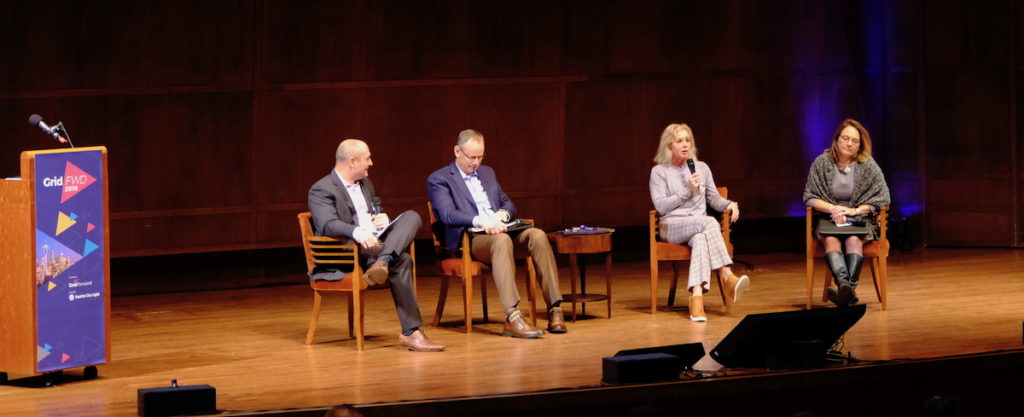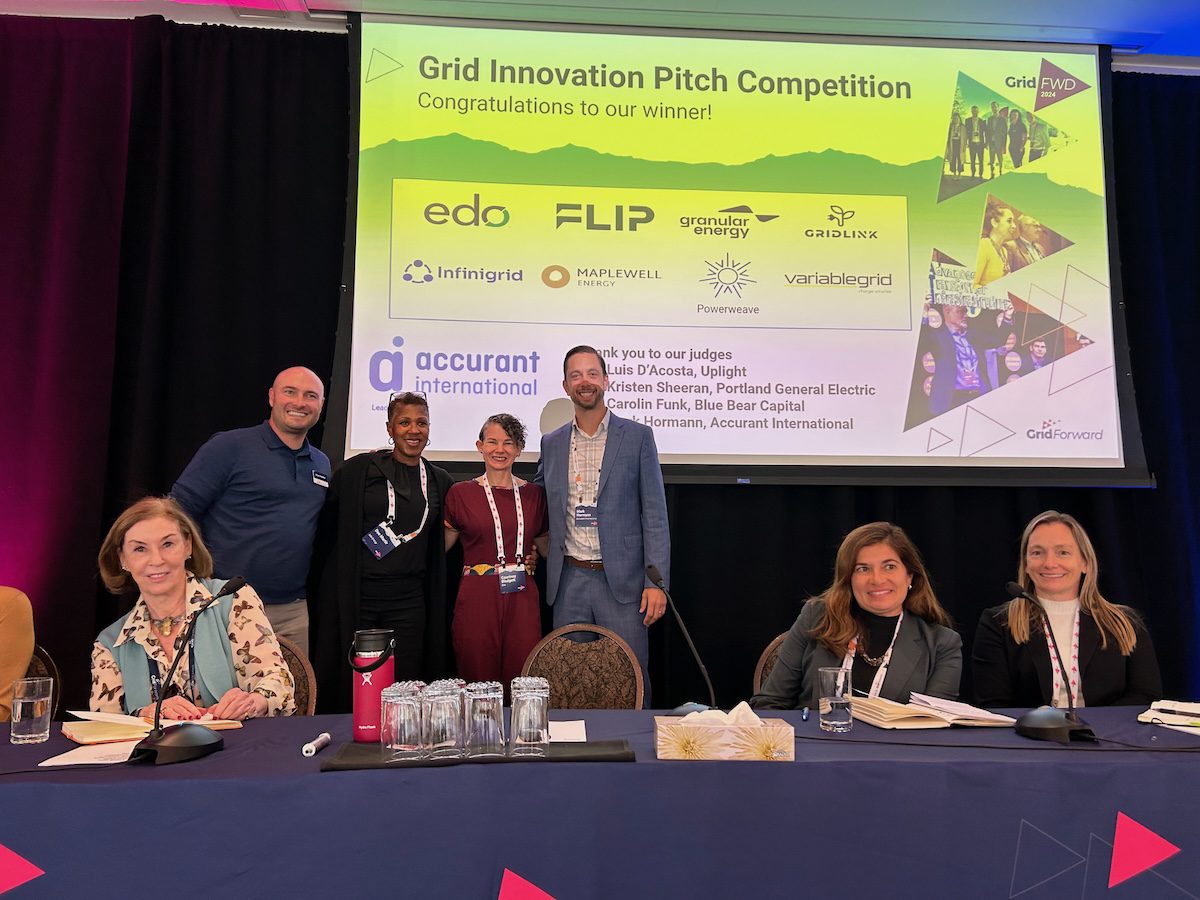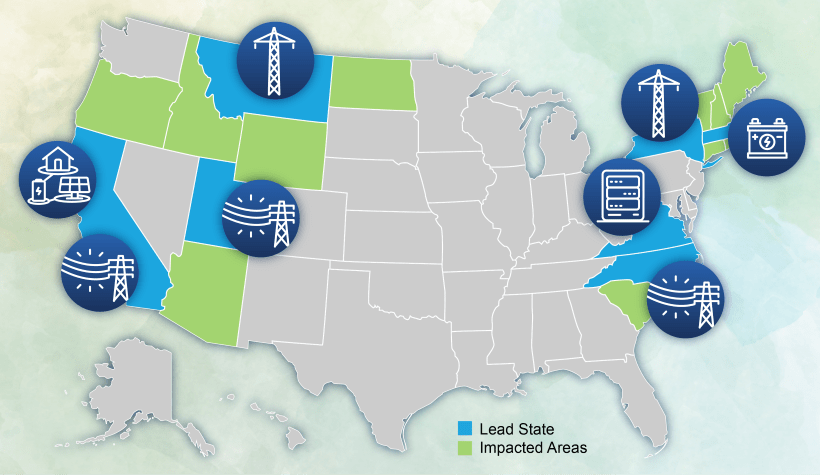Grid Modernization Perspectives from Regional Utility Leaders
GridFWD 2019 brought together over 400 regional and national experts to talk together about how to accelerate grid modernization in our region. The event’s many sessions covered grid modernization best practices, markets & models, and how to nurture a culture of innovation. Because the span of topics was so broad, and addressed by over 120 speakers, it was challenging to get a clear view of what’s immediately ahead. So we took the opportunity to ask five utility leaders who were in attendance (Steve Wright from Chelan PUD, Bear Prairie of Idaho Falls Power, Stefan Bird of Pacific Power, John Haarlow of Snohomish PUD and Jackie Flowers from Tacoma Public Utilities) about their views on what grid modernization looks like for 2020.
We’ve combined their answers into a two part series. This is part 1; click to read part 2.

Q1 – What is the most important grid modernization initiative you are planning for 2020?
The underlying platform for grid modernization is gathering and utilizing data from customer sites, distribution and transmission assets that can help utility operations monitor and manage the grid more effectively. Advanced metering infrastructure (AMI) is needed at customer sites to allow communication of usage data and program signals with the utility. While AMI has been a focus for some time now, rolling out AMI to an entire customer base takes time and a significant level of investment. The utility leaders we talked to are focusing on pushing this process ahead and, at the same time, preparing to make use of customer data.
This year, Tacoma Public Utilities is blueprinting its AMI project and preparing for the integration of all systems with the intention of rolling out meters in about a year. “We’re starting to work on related and complementary elements of our modernization strategy, specifically… how we’re going to collect and manage data,” said director Jackie Flowers. “We’re developing an ecosystem that promotes data-driven decisions and flexing the muscle where we have data now.” Tacoma is also mapping out strategy related to investments in technology to support future customer services.”
Chelan PUD is in a similar position, working to expand its fiber optics network to reach 85-90 percent of its customers, catching up with industry progress on AMI deployments, and moving ahead with customer information systems to make use of the data to come. The utility is using a new Oracle product to connect its customer information system to meter data management. “This is the place where we get to leap forward,” said general manager Steve Wright. “We’ll be rolling that out over the course of the next two years.”
Over at Snohomish PUD, AMI rollout is one part of the three-pronged grid modernization effort. “We are just starting our due diligence and outreach and overall strategic plan for the new meter technology,” explained CEO/general manager John Haarlow. “We’ve engaged in the first phase, a Customer Self-Service (CSS) program, that includes a Customer Facing portal to provide functionality for online payments, two-way texting, real-time payments, credit/debit card payments and enhanced outage management notifications.” The CSS is the foundation for the second phase with AMI.
For the third phase, Snohomish PUD is working on an RFP to upgrade its Advance Distribution Management System (ADMS) to improves outage response, enhanced network operation, restoration, resilience and asset utilization. “ADMS will also provide a path forward for non-wires solutions and integration of Distributed Energy Resources (DERs) in support of our solar microgrid, energy storage and other distributed resources,” Haarlow said. The timing of ADMS project will be coordinated with the new meters rollout. “These initiatives enable how we connect with our customers. We’ll be able to partner with them on providing incentives that will influence behaviors and lead to reducing capacity constraints on the grid.”
Some regional utilities are also investing in collecting and using data from the distribution system to improve operations. Stefan Bird, President and CEO of Pacific Power, the division of PacifiCorp that serves Oregon, Washington and California and oversees the company’s 10-state grid operations, says that the utility is making technology investments in both transmission and distribution to make the entire system smarter, more responsive, wildfire-resistant and agile, including a recent deployment of 590,000 smart meters throughout Oregon, its 2019 pilot of a fault location, isolation and service restoration (FLISR) system in Lincoln City, OR, and its addition of 2,000 miles of transmission lines across the West, called the Energy Gateway.
Idaho Falls Power is focusing on distribution automation for the next couple of years, running fiber to essential circuit switches and reclosers to enable fault location and system restoration. “As artificial intelligence and that type of technology continues to grow, there could be a future where that would be all automated,” said general manager Bear Prairie. “We’ll be essentially taking the first steps to the self-healing grid this year.”
Regional utilities will also making strides in 2020 to introduce more DERs into their systems and increase the share of renewable power. Notably, PacifiCorp recently released its 2019 IRP that calls for 7,000 MW of new renewables and storage and associated transmission upgrades by 2025, in parallel with over 2,800 MW of coal retirements by 2030. “Put simply, our goal is to connect our customers to the diversity of the West,” stated Bird. The 2019 IRP is “the roadmap by which we’ll accelerate our efforts and support the West’s energy transformation.”
Snohomish PUD will be expanding its Arlington microgrid in 2020 to build upon and learn from that experiment. “The project’s 500 kW community solar has been online since May,” said Haarlow. “We reserved over 50% of the project within the first day, and all solar units were reserved within 3 ½ weeks of launch. We were all very pleased with the strong community support.” Snohimish PUD is deploying a one megawatt lithium ion battery on the microgrid in 2020. In addition to providing hands-on experience operating solar and storage, the microgrid will also provide power to a co-located backup data center and a backup operations center in the event of an emergency.
Q2 – Are you partnering with any municipalities in your region or other new stakeholders to pursue exciting advanced technology acceleration?
Regional utilities are expanding their circles of partners to define and initiate grid modernization programs. Such collaboration starts with the municipalities in the utilities’ service areas, as they pursue their own clean energy, transportation and smart city programs. Snohomish PUD has started conversations with communities about how to leverage their visions alongside the direction and capabilities of the utility. For example, the city of Edmonds aims to be 100% carbon-free, and “we can carve out [our service] and provide that carbon free power” from Snohomish PUD’s hydro resources, said Haarlow.
Tacoma Public Utilities is “working with the City of Tacoma in terms of preparing them for what the future grid looks like, what our digital transformation strategies are, and what our end goal is,” Flowers explained. “There’s a very strong commitment to deep decarbonization and in particular, electrification of the transportation industry. So they’ve been a fantastic partner with us – rolling out rebates for electric vehicles, working with vendors and car dealers to buy down pricing of EVs.”
There are other local entities that can facilitate grid modernization, such as the regional national labs. Idaho Falls Power, with help from Idaho National Labs and Pacific Northwest National Labs, is investigating the use of run-of-river hydro plus energy storage systems to power microgrids. Their research will test whether these systems can restore power in black start conditions – powering critical loads independently in the event of a wider system outage – while also providing adequate system frequency and voltage stabilization.
Chelan PUD is collaborating more broadly to innovate in hydro generation through the Hydropower Research Institute it launched last year. “We’re working with folks not just in our region, but across North America, to identify those parties who are focused on operational excellence for their hydro projects,” explained Wright. He pointed out that the greatest opportunity for increased capability in the hydro system is reducing the number of forced outages. Today’s technology is very good at “translating the BTUs of falling water into kilowatt hours.” But the current hydropower system is at least 40 years old, so investment in advanced sensor technology to monitor turbine health can reap return by keeping those generators online.
Utilities are also turning to regional organizations to move ahead. Haarlow said that Snohomish PUD sees great value in working with agencies such as the Northwest Energy Coalition (NWEC). “As an example, they – and others as well – have provided us with insights, perspectives, suggestions and information on our rate design initiative. We are looking forward to working with them next on our Income Qualified program. This too is part of grid modernization. We’re leveraging the systems that we have and are putting in place programs such as CSS to make it easier for income-qualified customers to participate with our discount programs.”
In Utah, PacifiCorp’s Rocky Mountain Power division is partnering with sonnen and the real estate developer Wasatch Group to develop and manage the largest single U.S. residential battery demand response project, with 600 apartment-unit batteries totaling 12.6 MWh of solar-powered battery storage. “This innovative all-electric design will provide emergency back-up power to residents, help address air quality issues in the area and benefit our bulk grid operations,” explained Bird.
This is the first article in a two-article series. Click to read part 2.
### This article was sourced by David Smith and Miki Carlton, and written by David Smith and Lauren Bhaskar.



